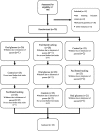Comparison of facilitated tucking and oral dextrose in reducing the pain of heel stick in preterm infants: a randomized clinical trial
- PMID: 32290829
- PMCID: PMC7155270
- DOI: 10.1186/s12887-020-2020-7
Comparison of facilitated tucking and oral dextrose in reducing the pain of heel stick in preterm infants: a randomized clinical trial
Abstract
Background: With the increase in hospitalization of premature infants in emergency departments and the painful procedure in these sectors, appropriate methods of pain relief are required. This study aimed to compare the effect of oral dextrose and facilitated tucking in the reduction of pain during heel sticks in premature infants and assess their effectiveness and feasibility for use in emergency settings.
Methods: This study was a randomized controlled clinical trial with cross-over design. Sixty infants were recruited from a Neonatal Intensive Care Unit (NICU) at Valiasr hospital in Tehran, Iran from March 2015 to September 2016. They were randomly allocated into three groups (no pain relief method, oral dextrose and facilitated tucking). Six blood samples were collected by heel stick for each infant. Oral dextrose and facilitated tucking were compared with the routine method of blood sampling and pain was measured two times for each method. The pain scores was measured by the Premature Infant Pain Profile (PIPP). Repeated Measure ANOVA, ANOVA and Scheffe post-hoc test were used with SPSS 16.
Results: The pain score's increase during heel stick was significantly lower after using oral dextrose (3.58 ± 0.34) and facilitated tucking (5.58 ± 0.53) in comparison to the routine method (8.91 ± 0.18) of blood sampling (P < 0.001, η2 = 0.971). Oral dextrose was more effective than facilitated tucking (P < 0.001, Cohen's d = 4.49). The emergency nurses rated oral dextrose as easier (t = 2.20, df = 118, p = 0.02, Cohen's d = 0.39) and more applicable method (t = 2.99, df = 118, p = 0.003, Cohen's d = 0.54) for the emergency department.
Conclusions: Facilitated tucking is an effective method of pain reduction which can be used in the absence of oral dextrose, in a situation in which it is contraindicated or in combination with oral dextrose. Based on the increase of infant's admission in emergency department future studies are needed to identify the best method of pain reduction for procedures in this setting.
Trial registration: Current Controlled Trials IRCT201408029568N9, 2014-09-08.
Keywords: Blood sampling; Emergency department; Nurses; Pain; Premature infant.
Conflict of interest statement
The authors declare that they have no competing interests.
Figures
References
-
- Lago P, Garetti E, Bellieni CV, Merazzi D, Savant Levet P, Ancora G, et al. Systematic review of nonpharmacological analgesic interventions for common needle-related procedure in newborn infants and development of evidence-based clinical guidelines. Acta Paediatr. 2017;106(6):864–870. doi: 10.1111/apa.13827. - DOI - PubMed
-
- Olsen K, Weinberg E. Pain-less practice: techniques to reduce procedural pain and anxiety in pediatric acute care. Clin Pediatr Emerg Med. 2017;18(1):32–41. doi: 10.1016/j.cpem.2017.01.007. - DOI
Publication types
MeSH terms
Substances
Associated data
LinkOut - more resources
Full Text Sources
Medical
Miscellaneous



